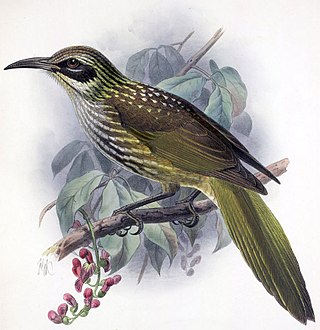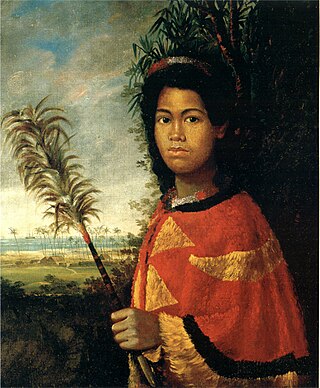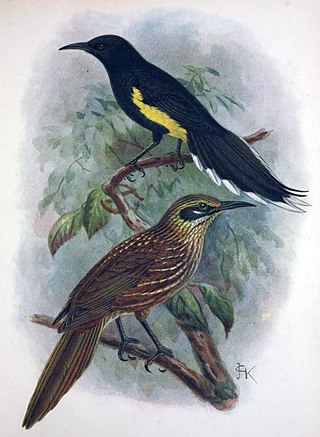
The regent honeyeater is a critically endangered bird endemic to southeastern Australia. It is commonly considered a flagship species within its range, with the efforts going into its conservation having positive effects on many other species that share its habitat. Recent genetic research suggests it is closely related to the wattlebirds.

The ʻiʻiwi or scarlet honeycreeper is a species of Hawaiian honeycreeper. The ʻiʻiwi is a highly recognizable symbol of Hawaiʻi. The ʻiʻiwi is one of the most common endemic birds of the Hawaiian Islands.

The Kauaʻi ʻōʻō or ʻōʻōʻāʻā was the last member of the ʻōʻō (Moho) genus within the Mohoidae family of birds from the islands of Hawaiʻi. The entire family is now extinct. It was previously regarded as a member of the Australo-Pacific honeyeaters.

The ʻōʻū is a species of Hawaiian honeycreeper endemic to the Hawaiian islands. It has a dark green back and olive green underparts; males have a yellow head while females have a green head. Its unusual beak seems to be adapted to feeding on the fruits of Freycinetia arborea. It has a strong flight which it uses to fly considerable distances in search of this vine, but it will eat other fruits, buds, flowers and insects.

The Hawaiian rail, Hawaiian spotted rail, or Hawaiian crake is an extinct species of diminutive rail that lived on Big Island of Hawaiʻi.

The kioea was a endemic Hawaiian bird that became extinct around the mid-19th century.

Moho is a genus of extinct birds in the Hawaiian bird family, Mohoidae, that were endemic to the Hawaiian Islands. Members of the genus are known as ʻōʻō in the Hawaiian language. Their plumage was generally striking glossy black; some species had yellowish axillary tufts and other black outer feathers. Most of these species became extinct by habitat loss, the introduction of mammalian predators, and by extensive hunting (their plumage was used for the creation of precious ʻaʻahu aliʻi and ʻahu ʻula for aliʻi. The Kauaʻi ʻōʻō was the last species of this genus to become extinct, likely a victim of avian malaria.

The Bishop's ‘ō‘ō or Molokai ‘ō‘ō was the penultimate member of the extinct genus of the ‘ō‘ōs (Moho) within the extinct family Mohoidae. It was previously regarded as member of the Australo-Pacific honeyeaters (Meliphagidae). Lionel Walter Rothschild named it after Charles Reed Bishop, the founder of the Bishop Museum.
The Tasman starling was described in 1836 by John Gould as a species which occurred on both Norfolk Island and Lord Howe Island. In 1928 Australian ornithologist Gregory Mathews recognized that the plumage of the race from Lord Howe Island was much browner and more greyish than the plumage of the Norfolk Island race and split the species into two forms, the Norfolk starling, and the Lord Howe starling. Both subspecies are now extinct, thus so the species.

Mamo or woowoo is a common name for two species of extinct birds. Together with the extant ʻIʻiwi they make up the genus Drepanis. These nectarivorous finches were endemic to Hawaii but are now extinct.

The O‘ahu ‘ō‘ō was a member of the extinct genus of the ‘ō‘ōs (Moho) within the extinct family Mohoidae. It was previously regarded as member of the Australo-Pacific honeyeaters (Meliphagidae).

The Hawaiʻi mamo is an extinct species of Hawaiian honeycreeper. It was endemic to Hawaii Island. It became extinct due to habitat loss, mosquitoes, introduced predators such as the small Indian mongoose, and overcollecting.

The ʻākohekohe, or crested honeycreeper, is a species of Hawaiian honeycreeper. It is endemic to the island of Maui in Hawaiʻi. The ʻākohekohe is susceptible to mosquito‐transmitted avian malaria and only breeds in high‐elevation wet forests.

The kākāwahie or Molokaʻi creeper is an extinct species of Hawaiian honeycreeper. It was found on the Hawaiian island of Molokaʻi in Hawaii.

The grey-headed honeyeater is a species of bird in the family Meliphagidae. It is endemic to Australia.

The kāmaʻo or large Kauaʻi thrush was a small, dark solitaire endemic to Kauaʻi in the Hawaiian Islands.

Nāhiʻenaʻena's Pāʻū is the largest known piece of Hawaiian feather work. It is a feather skirt (pāʻū) made for Princess Nāhiʻenaʻena.

Mohoidae, also known as the Hawaiian honeyeaters, was a family of Hawaiian species of now recently extinct, nectarivorous songbirds in the genera Moho (ʻōʻō) and Chaetoptila (kioea). These now extinct birds form their own family, representing the only complete extinction of an entire avian family in modern times, when the disputed family Turnagridae is regarded as invalid. The last surviving species in the family, the Kauai O'o, became extinct after 1987.





















